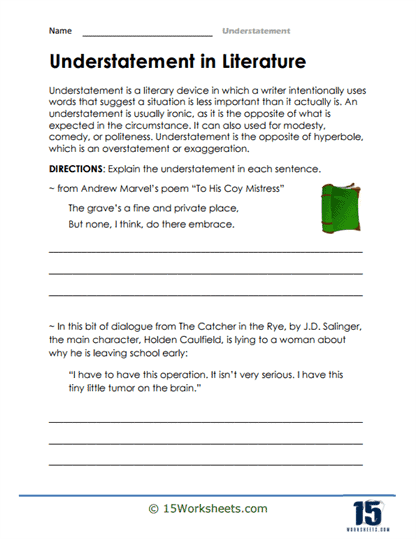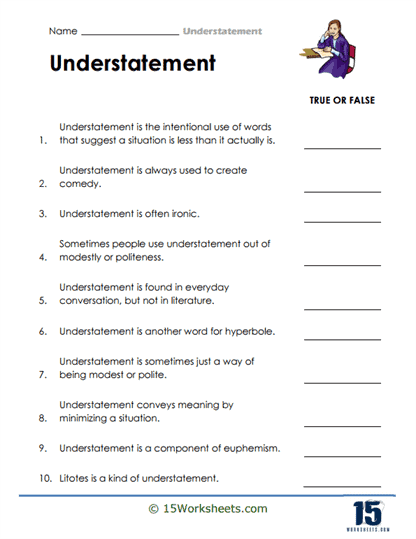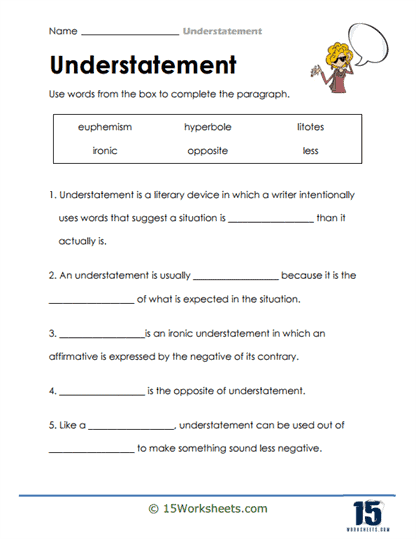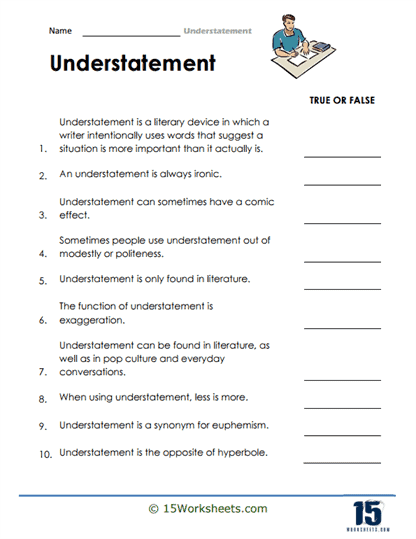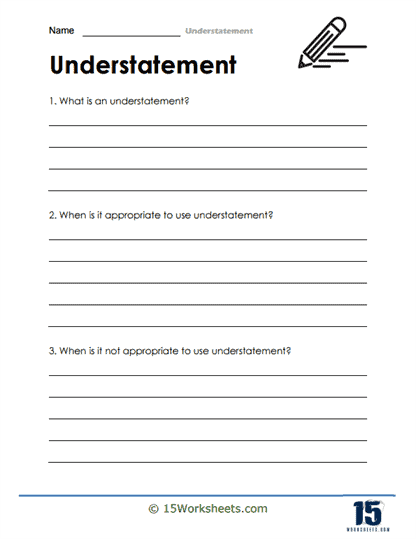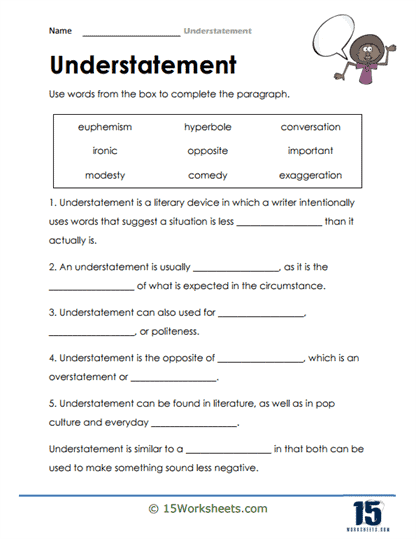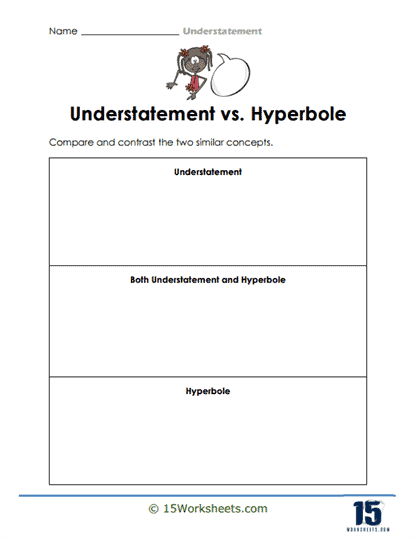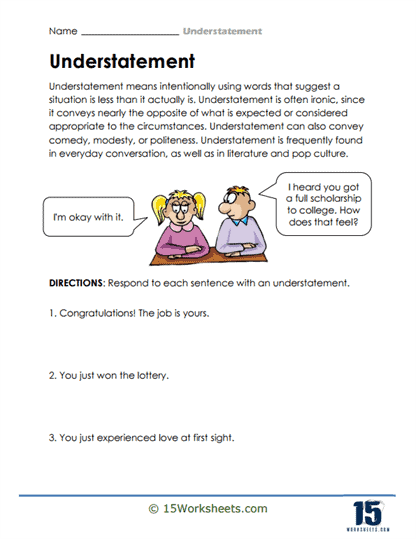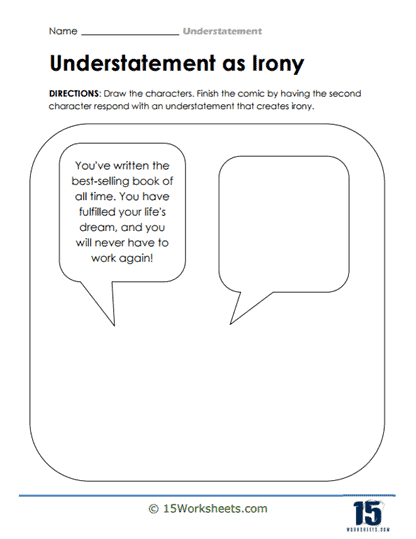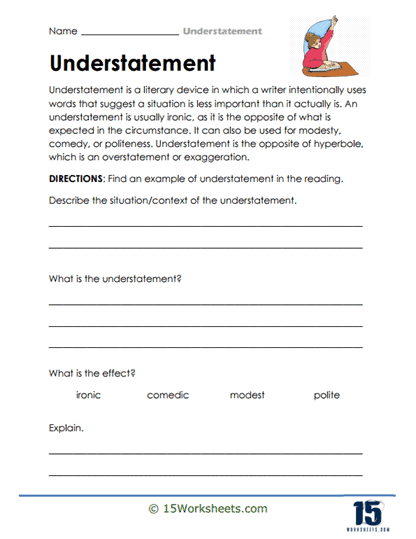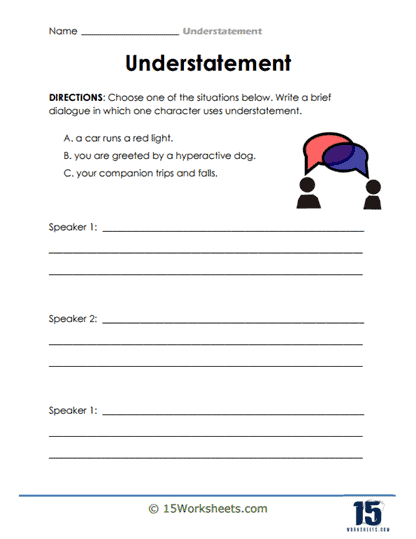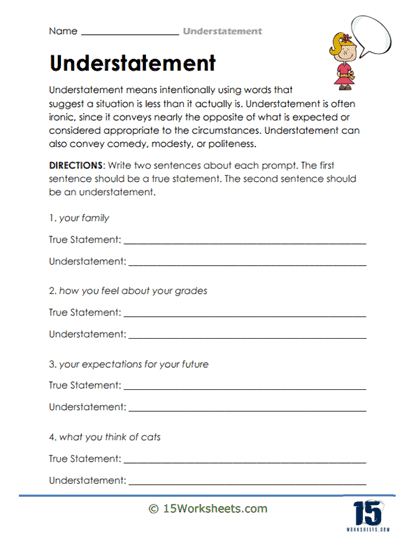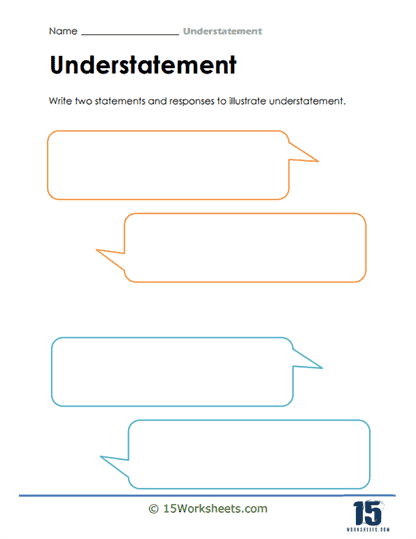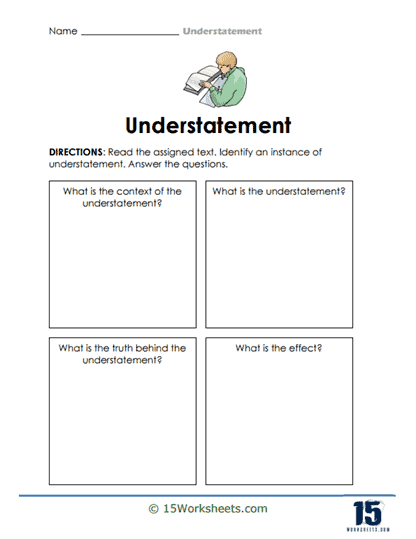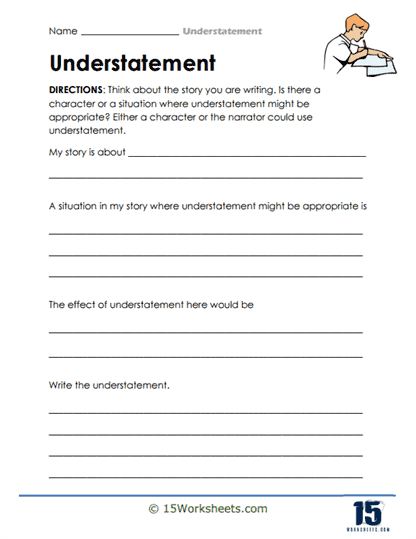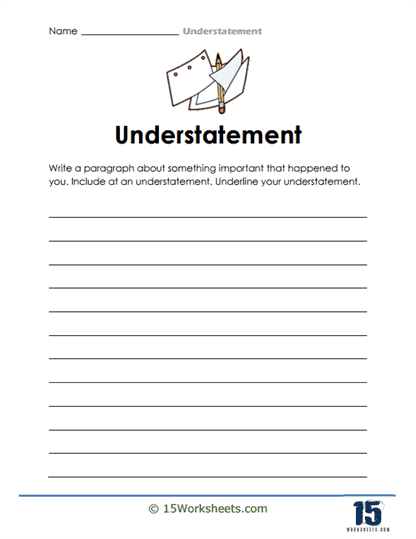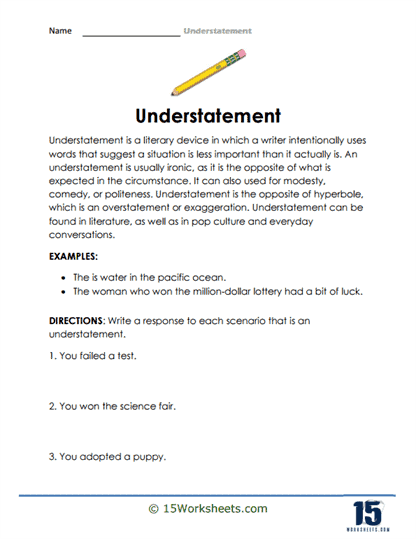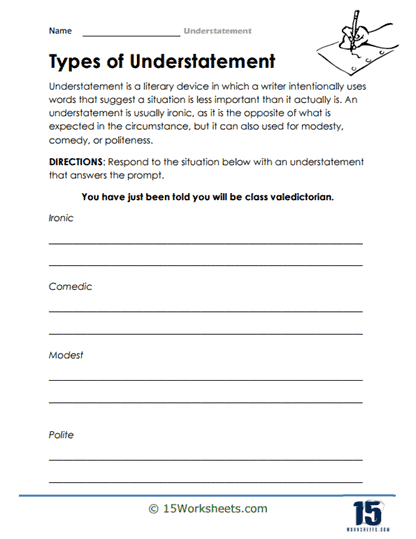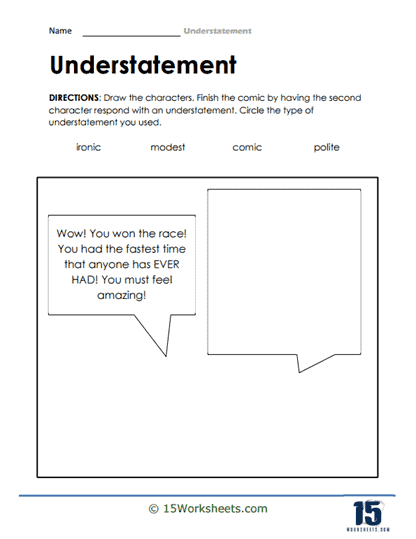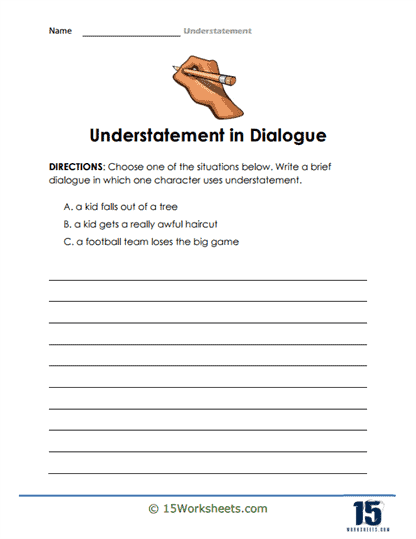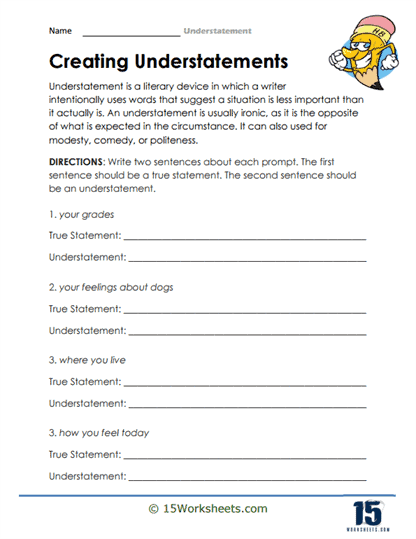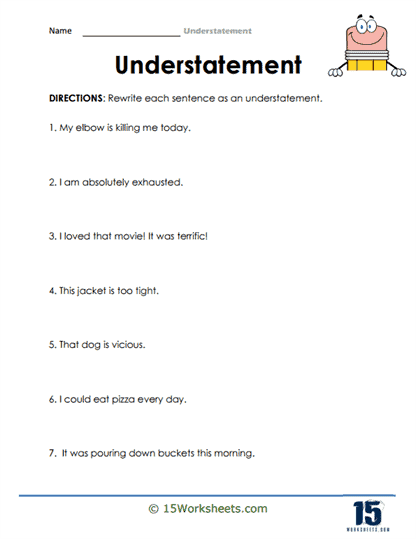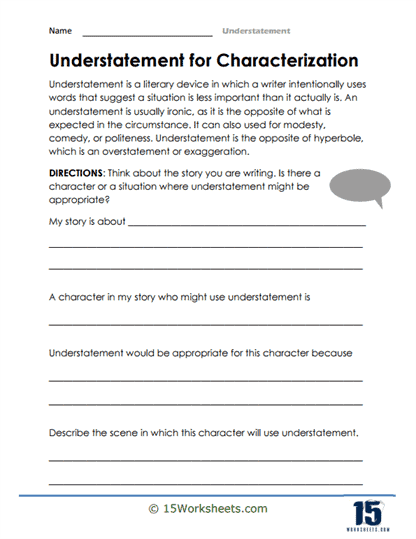Understatement Worksheets
About These 15 Worksheets
These worksheets will help student understanding and application of the rhetorical device known as understatement. An understatement is a figure of speech where the expression minimizes the importance, severity, or magnitude of a subject or situation, often for ironic or humorous effect. These worksheets are integral to language arts education, offering a structured approach to learning how to recognize, interpret, and use understatement in both writing and speech.
Through a variety of exercises, these worksheets not only enhance students’ understanding of understatement but also contribute to their overall language proficiency, reading comprehension, and expressive capabilities. By integrating understatement into their linguistic toolkit, students become more nuanced readers and writers, capable of appreciating and employing the subtleties of language to great effect. The skills developed through practicing with understatement worksheets are transferable across the curriculum, enriching students’ academic and personal communication skills and preparing them for a lifetime of effective and creative language use.
Types of Exercises
Understatement worksheets encompass a variety of exercises tailored to different learning levels and objectives. These exercises are designed to gradually build the student’s ability to understand and use understatement effectively. The most common types of exercises include:
Identification – Students begin with exercises aimed at identifying understatement in sentences, paragraphs, or larger texts. These tasks may present a mix of sentences, some using understatement and others using overstatement or straightforward language, and students must determine which sentences contain understatement.
Matching – These involve matching statements with their understated counterparts. This helps students understand how understatement changes the tone or impact of a statement. Prompts that encourage students to incorporate understatement into their own writing. This could range from crafting sentences to composing short stories or essays where understatement plays a key role in the narrative or argument.
Rewriting – Students take sentences or short paragraphs and rewrite them using understatement. This not only reinforces their understanding of the concept but also encourages creative thinking and application.
Reading Comprehension – These exercises integrate understatement into larger texts, asking students to identify instances of understatement and analyze their effect on the reader’s perception or the text’s tone.
Comparison – Students compare and contrast the use of understatement with other rhetorical devices such as hyperbole. This helps in understanding the nuanced differences between various figures of speech.
Interpretation – These require students to interpret the meaning behind an understatement, considering context and tone. It helps in developing deeper reading comprehension skills.
The Benefits of These Worksheets
Practicing with understatement worksheets offers numerous benefits in the realm of language arts and reading skills, notably:
Enhanced Comprehension Skills – Students learn to recognize subtleties in language, improving their ability to understand nuanced meanings and inferential messages in texts. This is crucial for advanced reading comprehension and critical analysis.
Improved Writing Skills – By learning to use understatement, students can enrich their writing style, making it more engaging, persuasive, or humorous. It adds depth to their writing and helps them express ideas in a more sophisticated manner.
Increased Vocabulary and Language Awareness – The exercises encourage students to explore different ways of expressing ideas, which broadens their vocabulary and enhances their overall language awareness.
Critical Thinking and Interpretation – Understanding and using understatement requires students to think critically about language and its impact. They learn to interpret what is not being said directly, which is a valuable skill in reading between the lines of both literature and everyday communication.
Engagement with Texts – Learning about understatement and other figures of speech makes students more engaged readers who can appreciate the stylistic choices writers make. This can lead to a deeper appreciation of literature and more insightful literary analysis.
Adaptability in Communication – Understanding how understatement can alter the tone or perceived seriousness of a message allows students to become more adaptable communicators. They learn to adjust their language according to their audience and purpose.
Enhanced Creativity – The creative writing exercises encourage students to think outside the box and use language in innovative ways. This not only improves their writing skills but also fosters a love for creative expression.
What is the Literary Device of Understatement?
The literary device of understatement is a nuanced and potent tool in the arsenal of authors and writers, enabling them to convey meanings in a subtle, often humorous or ironic manner. By deliberately presenting a situation or a feeling as less important, severe, or significant than it actually is, understatement can transform the tone of a narrative, enrich character portrayal, and engage the reader on a deeper level. This essay delves into the essence of understatement, its defining features and characteristics, provides examples from literature, and explores the effects it has on the reader.
The Defining Feature of Understatement
The main defining feature of understatement is its intentional reduction of the significance, magnitude, or intensity of a subject or situation. Unlike hyperbole, which exaggerates for effect, understatement minimizes the perceived impact, often leading to a contrast between what is said and what is meant or understood. This discrepancy is where the power of understatement lies, offering readers a glimpse into the subtleties of the writer’s intent and the complexities of the narrative or argument.
Characteristics of Understatement
Understatement typically exhibits several key characteristics:
Subtlety – It is subtle in its delivery, requiring discernment from the reader to grasp the full extent of what is being conveyed.
Irony – Often, understatement carries an ironic tone, with the actual situation being markedly different from the one described.
Humor – Many times, understatement is used to inject humor into a narrative, with the disparity between what is said and reality creating a comedic effect.
Emphasis – Paradoxically, by downplaying certain elements, understatement can actually place more emphasis on them, drawing the reader’s attention to their true importance.
Tact and Diplomacy – It can be a means of expressing criticism or negative sentiments in a more palatable manner, showing tact and diplomacy.
Examples of Understatement in Literature
Let’s explore three examples of understatement in literature and examine their significance and effect:
“The Catcher in the Rye” by J.D. Salinger – The protagonist, Holden Caulfield, often uses understatement to convey his feelings and experiences. For instance, when he talks about being expelled from multiple schools, he downplays his feelings of failure and isolation by treating these significant life events as mere inconveniences. This understatement allows readers to see the depth of Holden’s disillusionment and alienation from society, making his character more relatable and his internal turmoil more palpable.
“Pride and Prejudice” by Jane Austen – Austen frequently employs understatement to critique societal norms and character flaws. A notable example is Mr. Bennet’s use of understatement regarding his indifferent marriage. He often makes light of serious issues in his family dynamics, which on the surface might seem humorous but also subtly highlights his disengagement and the consequences of social expectations on personal relationships. Austen’s use of understatement thus enriches the social commentary woven throughout her narrative.
“To Kill a Mockingbird” by Harper Lee – Atticus Finch’s description of the racist attitudes in Maycomb as “Maycomb’s usual disease” is a profound understatement. This minimalistic portrayal of deep-seated racism not only underscores its pervasive nature but also Atticus’s calm, measured approach to challenging it. Through this understatement, Lee emphasizes the normalcy of racial prejudice in the setting, inviting the reader to reflect on the enormity of the issue presented in such a subdued manner.
The Effect of Understatement on the Reader
The use of understatement in literature has a multifaceted impact on the reader. Firstly, it engages the reader’s intellect and imagination, requiring active participation to discern the true meaning or gravity of what is being understated. This involvement deepens the reader’s engagement with the text and enhances the reading experience.
It often creates a bond of complicity between the writer and the reader, with the shared understanding of the discrepancy between the stated and the actual adding an additional layer of enjoyment or insight.
Understatement can elicit a range of emotional responses, from amusement to empathy, by presenting situations or emotions in a restrained manner. It encourages readers to read between the lines, fostering a deeper emotional connection to the characters and the narrative.
Understatement can serve as a powerful tool for critique and commentary, allowing authors to highlight societal issues, character flaws, or thematic elements in a subtle yet impactful way. It can provoke thought and reflection, prompting readers to reconsider their assumptions and perspectives.

